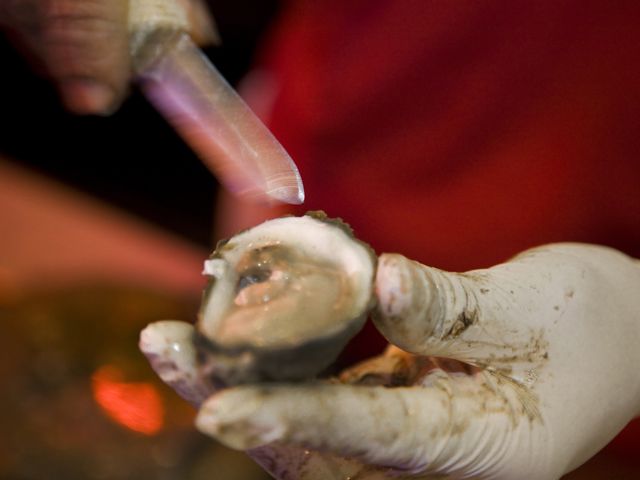
reference-image, l
(article, Sara Franklin)
[%pageBreakSettings nobreak=true][%adInjectionSettings noInject=true] Five autumns ago, just a month after Hurricane Katrina overwhelmed New Orleans, the Times-Picayune reporter Chris Rose wrote of the ever-worsening stench and freakishly unusual dry spell in town: “It has been three weeks since it rained — since you know when — and that’s as unfathomable a notion here as a September without oysters.” New Orleanians still talk about The Storm. But even Katrina left oysters behind. This past autumn, five months after the BP oil spill began to pollute the Gulf of Mexico, I found myself meandering the streets of the city’s famous French Quarter, looking in vain for oysters. The unfathomable had come to pass. [%image reference-image float=right width=400 caption="Shucking an oyster."]I’m not from New Orleans, but the very name conjures up oysters: fried and stuffed into po’ boys, glistening on the half shell, soaked in stew. So what had happened to the oysters of the Big Easy? I decided to find out. At P&J Oyster Company, I talked with Al Sunseri. Family-run since the 1850s, P&J is one of the most revered oyster names in town. “We have the least amount of oysters since the spill this week,” Sunseri told me in October. “Very few oysters are being landed. “In Katrina, oyster families lost their homes, but managed to save their boats. And the farms were OK,” Sunseri added. “This is worse than Katrina.” In recent decades, nearly 40 percent of the U.S. oyster supply has come from Louisiana. The state is blessed with innumerable brackish estuaries — perfect oyster incubators. Over the last several months, however, the state has provided just five to 10 percent of the country’s oysters. In the wake of the BP oil spill, public opinion remains skeptical about Gulf seafood safety. But demand for oysters is still high. In New Orleans before the spill, a dozen oysters on the half shell typically cost about $6. Lately, the same appetizer has gone for nearly $37. And suppliers are struggling to find sources to meet the demand. Louisiana is one of the last bastions of “natural” oysters in the U.S. Many other regions where oysters used to abound —the Pacific Northwest, Chesapeake Bay, New York Harbor, and Maine — have fallen victim to urban sprawl and water pollution. In Louisiana, however, the estuaries remain largely rural. Louisiana oyster farmers have not had to turn to hatcheries — the standard industry response to estuary degradation — to ensure a steady supply. As a result, Louisiana oyster farms are cheaper to run, albeit more susceptible to natural (and unnatural) disasters. I had imagined that the region’s oysters had all been smothered by the spill, a sort of sticky oystercide. Actually, Sunseri explained, water diversions caused most of the problems. Pipes and valve lines regularly move fresh water into Louisiana estuaries, to foster artificially what the levees prevent from happening naturally. After the spill, engineers and environmentalists used these hydro diversions to pummel estuaries with significantly more fresh water than normal, in the hope of keeping the spreading slicks out. But the salinity imbalance created by the influx of “sweetwater” made it impossible for oysters to spawn. [%image oysterman float=left width=400 caption="Peter Vujnovich, Pete Vujnovich's son, carries on the family tradition."] Since then, many local chefs have turned to corporate suppliers like U.S. Foodservice and Sysco, who can provide cheap frozen oysters from Texas, the farther reaches of Louisiana, and Florida. But a few chefs have pulled oysters from their menus altogether, vowing to do without until Gulf oysters are abundant again. Sunseri put me in touch with Pete Vujnovich, a third-generation oyster farmer who’s one of P&J’s longtime suppliers. “The freshwater diversions killed over 60 percent of the oysters, and 25 percent of the crop has oil over it,” Vujnovich told me. “The water just isn’t right. I wouldn’t be comfortable harvesting oysters from those areas. And oil slicks come over the oysters with the tides.” Vujnovich is also concerned about the use of chemical dispersants on the oil. “We don’t really know about their long-term effects,” he said. “Is the oil just on the surface or is it down in the water column? What are the long-term biological effects?” Some of Vujnovich’s colleagues filed damage claims before their oyster flats were closed this past spring, voluntarily ceasing work in order to speed up their claim payments. In late May, he filed a claim as well. “Do you invest in your future as an oyster farmer or not? Do you invest your claims money or live on it? Will the market ever be there again?” he asked. “Since the summer of my freshman year of high school, I’ve always been on the boat. I love it. And I’m too old to start over.” [%image Pete float=right width=400 caption="Pete Vujnovich"]Vujnovich worries about what will happen if the situation in the Gulf loses its national prominence. “At first, we had all the big papers and the TV crews, but now the story has kind of died off,” he said. “But the effects are going to go on for years. A lot of people are really suffering and not seeing any money. If the media coverage dies, will BP backslide on their promises?” And that's a bigger concern than whether or not Gulf oysters made it into your Thanksgiving stuffing this year. p(bio). Sara Franklin is a food-systems consultant and writer based in Brooklyn, New York.

reference-image, l

oysterman, l

Pete, l